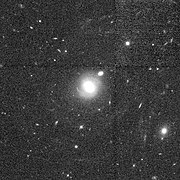Malin 1
| Malin 1 | |
|---|---|
 Image by the DESI Legacy Imaging Surveys, Data Release 10 | |
| Observation data (J2000.0[1] epoch) | |
| Constellation | Coma Berenices [2] |
| Right ascension | 12h 36m 59.34697s [1] |
| Declination | +14° 19′ 49.1585″ [1] |
| Redshift | 0.082702±0.000013 [3] |
| Heliocentric radial velocity | 24750±10 km/s [3] |
| Galactocentric velocity | 24707±10 km/s [3] |
| Apparent magnitude (V) | 15.809±0.009[3] |
| Absolute magnitude (V) | −22.01±0.50[3] |
| Characteristics | |
| Type | SB0a [1] |
| Mass | ~1012[4] M☉ |
| Size | 34.11 to 36.39 kpc (111,250 to 118,690 ly) (diameter; D25.0 B-band and 2MASS K-band total isophotes)[3][a] |
| Apparent size (V) | 0.25′ × 0.23′[3] |
| Notable features | Surrounded by a H I disk |
| Other designations | |
| PGC 42102, LEDA 42102, VPC 1091, 2MASX J12365934+1419494, Gaia DR2 3932516418935413504[1] | |
Malin 1 is a giant low surface brightness (LSB) spiral galaxy.[1][5] It is located 1.19 billion light-years (366 Mpc) away in the constellation Coma Berenices, near the North Galactic Pole. As of February 2015[update], it is the largest known spiral galaxy, with an approximate diameter of 650,000 light-years (200,000 pc),[6][7][8] thus over six times the diameter of our Milky Way. It was discovered by astronomer David Malin in 1986 and is the first LSB galaxy verified to exist.[5][8][6] Its high surface brightness central spiral is 30,000 light-years (9,200 pc) across, with a bulge of 10,000 light-years (3,100 pc).[6] The central spiral is a SB0a type barred-spiral.[6]
Malin 1 is peculiar in several ways: its diameter alone would make it the largest barred spiral galaxy ever to have been observed.[4]
Malin 1 was found later to be interacting with two other galaxies, Malin 1B and SDSS J123708.91+142253.2. Malin 1B is located 46,000 light-years (14,000 pc) away from the high surface brightness central spiral of Malin 1, which may be responsible for the formation of the galaxy's central bar. Meanwhile, SDSS J123708.91+142253.2 is located within the huge, faint halo of Malin 1 and might have caused the formation of the extended low surface brightness disc through tidal stripping.
Observations by Galaz et al. in April 2014 revealed a detailed view of the spiral structure of Malin 1 in optical bands. The galaxy exhibits giant and very faint spiral arms, with some segments up to 33,000 light-years (10,000 pc) in diameter. Other details, such as possible stellar streams and formation regions, are revealed as well.[9] The same authors also say that Malin 1 is larger than thought, with another estimated diameter of around 750,000 light-years (230,000 pc).[9]
Gallery
-
 Processed image of Malin 1 by Giuseppe Donatiello showing its weak spiral arms.
Processed image of Malin 1 by Giuseppe Donatiello showing its weak spiral arms. -
 Malin 1 imaged in grayscale by the Hubble Space Telescope.
Malin 1 imaged in grayscale by the Hubble Space Telescope.
See also
- NGC 6872, large interacting barred spiral galaxy claimed in 2013 as largest spiral galaxy
- NGC 262, lenticular galaxy surrounded by a huge H I cloud discovered in 1885
- UGC 2885, a large unbarred spiral galaxy
Notes
References
- ^ a b c d e f "2MASX J12365934+1419494". SIMBAD. Centre de données astronomiques de Strasbourg. Retrieved 27 October 2010.
- ^ "PGC 42102". WikiSky. Archived from the original on 7 March 2019. Retrieved 27 October 2010.
- ^ a b c d e f g h "Detailed Information for Object Malin 1". NASA/IPAC Extragalactic Database. Retrieved April 18, 2012.
- ^ a b Barth, Aaron J. (March 2007). "A Normal Stellar Disk in the Galaxy Malin 1". The Astronomical Journal. 133 (3): 1085–1091. arXiv:astro-ph/0701018. Bibcode:2007AJ....133.1085B. doi:10.1086/511180. S2CID 14631639.
- ^ a b Bothun, Gregory D. (February 1997). "The Ghostliest Galaxies". Scientific American. 276 (2): 56–61. Bibcode:1997SciAm.276b..40B. doi:10.1038/scientificamerican0297-56. JSTOR 24993608.
- ^ a b c d Crosswell, Ken (22 January 2007). "Malin 1: A Bizarre Galaxy Gets Slightly Less So". KenCroswell.com.
- ^ Dorminey, Bruce (22 December 2013). "Astronomers Still Puzzle Over 'Low Surface Brightness' Galaxies". Forbes. Retrieved 30 December 2014.
- ^ a b Glenday, Craig, ed. (2011). Guinness World Records 2011. New York: Random House. p. 3. ISBN 978-0-440-42310-2.
- ^ a b Galaz, Gaspar; et al. (December 2015). "Deep Optical Images of Malin 1 Reveal New Features". The Astrophysical Journal Letters. 815 (2). L29. arXiv:1512.01095. Bibcode:2015ApJ...815L..29G. doi:10.1088/2041-8205/815/2/L29. S2CID 31114340.
External links
 Media related to Malin 1 at Wikimedia Commons
Media related to Malin 1 at Wikimedia Commons
- v
- t
- e
| Bayer | |
|---|---|
| Flamsteed | |
| Variable | |
| HR | |
| HD | |
| Other |
| Exoplanets |
|---|
| Star clusters |
|---|
| Nebulae |
|---|
| Galaxy clusters |
|---|
| Astronomical events |
|---|
 Category
Category













